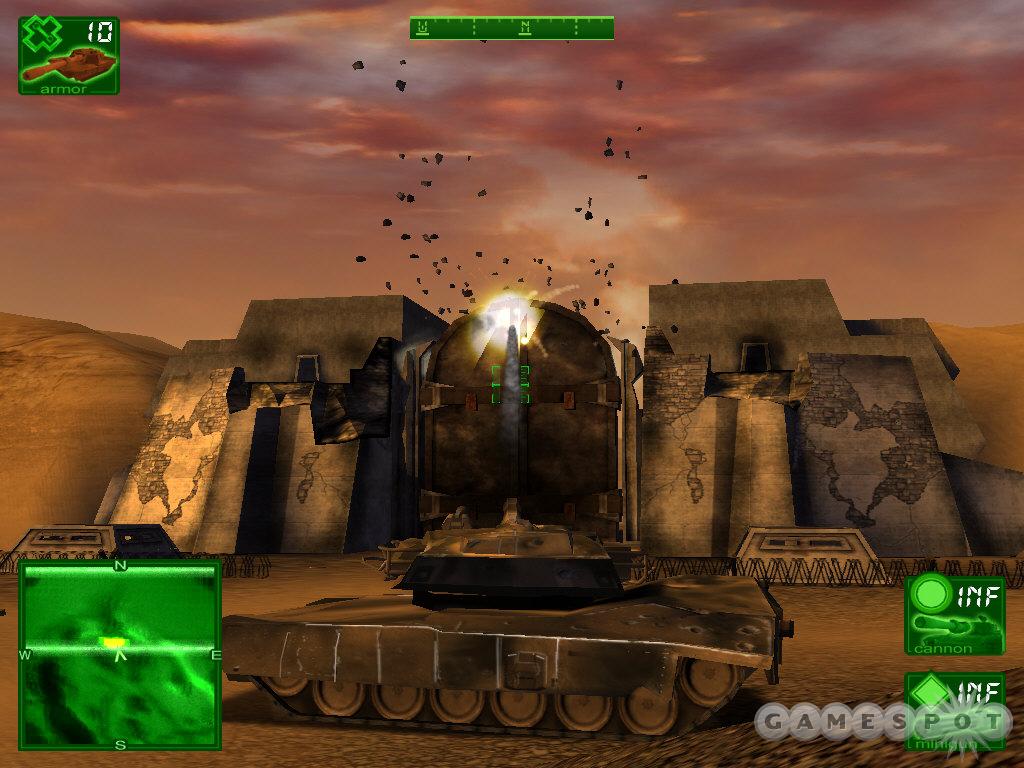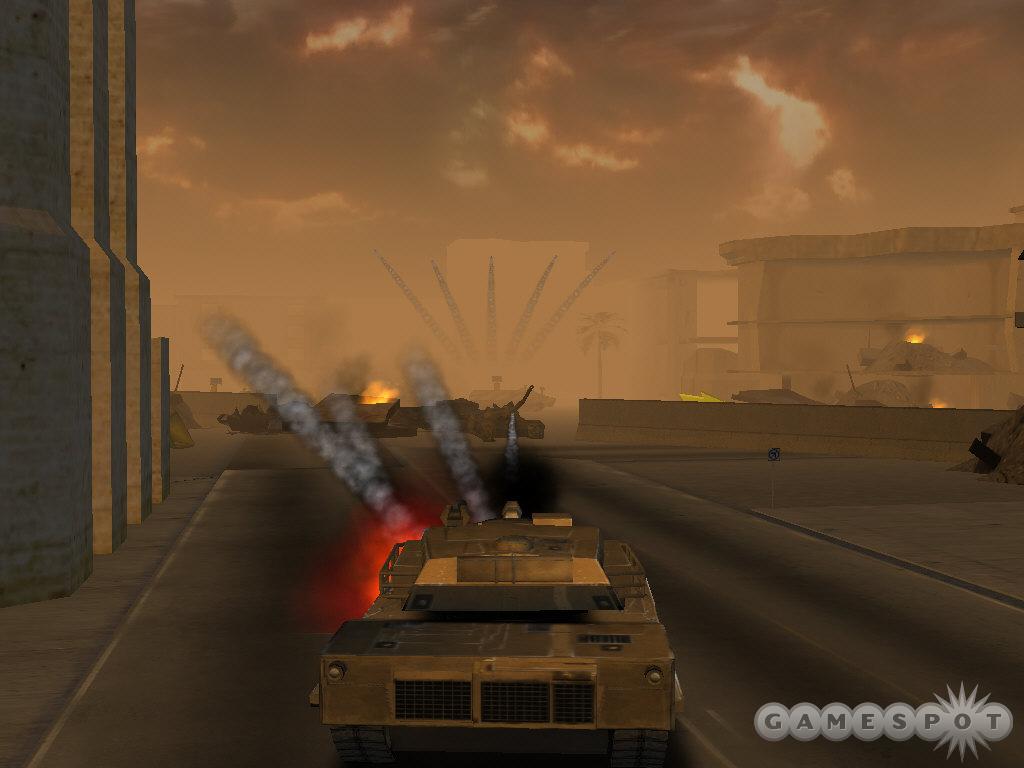A budget-priced game that adopts some of today's hottest technologies--in this case, Unreal's graphics engine and MathEngine's vaunted Karma physics modeling--is not something you see every day. It's especially rare when it's blended with a storyline that's not only contemporary but also downright pertinent to current headlines. Nevertheless, this is precisely the formula behind Groove Games' Desert Thunder, a shoot-first-and-ask-questions-later tank-based orgy of ordnance. The good news is that Desert Thunder is a sensory overload of explosive, destructive good times that'll cost less than a family outing at the local fast-food joint. The bad news is that the game is so easy to learn and so very arcade-oriented that anyone who appreciates longevity, tactics, and even a modicum of authenticity will inevitably be disappointed.

Designed by first-time developer Brainbox Games, Desert Thunder is a rough-and-tumble affair that puts you in the role of a tank commander who is stationed in an unnamed Middle Eastern hot spot. As is customary for most games of this ilk, you are the only remaining representative of the "forces of good." Everyone else has been permanently wiped from the map, and scheduled reinforcements are nowhere to be found. As a result, you and you alone must now battle hordes of unidentified terrorists.
As the game opens, you'll find yourself looking down upon your vehicle from a slightly elevated rear-chase perspective. You may raise or lower this vantage point and adjust the camera so that it follows either your swiveling turret or your tank, but otherwise, this is the only camera in Desert Thunder. Zooming is not permitted at any time, neither in the main window nor in the miniature topographical map/radar located in the lower left of the screen. You cannot access enemy views, weapons views, or binocular views, nor can you look freely about the countryside. And you can't jump inside your machine for a first-person perspective, either.
This absence of perspective variance is one of the big problems in a game that concerns itself primarily with the fine art of tank warfare. Though Desert Thunder often requires you to battle enemies over great distances or when hidden just behind a hillside or massive outcropping, it doesn't offer the necessary viewing tools for the job. Additionally, the game doesn't give you any method for controlling--or even knowing--the maximum length, the proposed arc, or the trajectory of your upcoming cannon or minigun volleys. Instead, you can only adjust your positioning and move your turret up and down blindly, not really knowing if you have a good read on the current situation until you've actually fired off a couple of volleys. Worse still, you can't adjust your cannon into a steep enough orientation to effectively lob shells toward short distance targets. Consequently, if you need to attack an enemy who's just 50 feet away but is positioned on the other side of an obstacle, you're forced to bring yourself, at least partially, into the open to do so. Furthermore, you're never able to stealthily tuck yourself away behind an object, which prevents you from skillfully working out a proper trajectory for your attack.
That having been said, Desert Thunder is far from a stealthy game. In reality, this is an action-packed arcade-style game. Moreover, unless you really need to use a given object for cover, the suggested tactic is to shoot everything that looks even marginally shootable. That list includes live enemy vehicles, the smoking hulks of damaged enemy vehicles, large fortresses, small structures, guard towers, airplanes, and even perfectly innocent boulders and palm trees. Why? Because there's a chance that by taking out that big rock in front of you, you'll also impact or kill the enemy who's hiding behind it. Furthermore, many of the seemingly most innocuous objects house the very staple of the Desert Thunder world--the power-up.

Yes, Desert Thunder has power-ups. When you begin the game, you have an infinite number of basic cannon shells and basic minigun rounds. But to appreciably advance, you need the beefed-up ordnance you can only find through power-ups. Whether you uncover a high-impact shell, a homing shell, a hellfire shell, an armor-piercing minigun round, or a 10-percent or 50-percent repair token is unknown, but you can bet that you'll discover at least one of the above in every three or four rocks or palm trees that you demolish.
Certainly, you'll need all the help you can get when you move beyond the game's "easy" level to the "standard" level and then to the ultra-demanding "difficult" levels. Newcomers will undoubtedly want to first try their hands at easy mode, where they can most often barnstorm through their enemies without too much fear. Here, they'll face substantially smaller numbers and significantly less-destructive firepower. However, when campaigning the "standard" or "difficult" levels, the sheer number of enemy forces and the damage factor of their weapons grows by leaps and bounds. At the difficult setting, wherein adversaries attack the moment you become visible, the game's lack of advanced targeting and camera/zoom functions becomes a serious detriment. Ultimately, you'll be compelled to play in a fastidiously cautious fashion by creeping along--sometimes an inch or two at a time.
As challenging as its difficult level is, Desert Thunder can never be accused of being a long-term affair. Indeed, in easy mode, most experienced action players should polish off the entire game, from beginning to end, within a single afternoon. The question then becomes whether the excitement of seeing the exact same landscape in the exact same linear fashion (but with far more enemies and harder-hitting weapons) is enough of a driving force for another go. If you're the type who appreciates a good firefight and oodles of impressive explosions, it probably will be. If you're looking for more variety or a more deeply engaging or authentic experience, it probably won't. In the end, even the most ardent fan will have trouble seeing this game through more than just a few days.

From a purely visual standpoint, Desert Thunder feels both stripped-down and impressive at the same time. On the upside, the game's resemblance to the latest versions of Unreal is evident. Though the stars of the show--the tanks--are somewhat primitively rendered, the majority of the scenery is relatively solid. Enemy soldiers are authentically drawn and are fully reactive to the situation. They may react a bit oddly at times--by walking into the open and letting loose with their rifles or rocket-propelled grenades--at least they don't stand there motionless. As for enemy tanks, the truth is that it's difficult to distinguish a T-72 from a more powerful T-90. The slickest vehicle of all is the mobile antitank vehicle, which launches a spectacular flurry of homing missiles that inevitably find their target.
The game is at its best when you're simply out there blowing stuff up. Whether targeting a group of enemy foot soldiers on a bridge, a top-heavy guard tower, or just a brick-built apartment building on a city street, you can be rest-assured that the item in question will explode in a profusion of smoke, fire, and broken parts. Certain players may also enjoy the bloody thrills that come from running down a foot soldier or blowing one off of a rooftop.
Nevertheless, the presentation is clearly not as sophisticated as it could be. Most vexing is the game's distance-fogging, which impacts the game aesthetically and makes far-off targeting an impossibility. As soon as an enemy comes into view, it has most likely seen you as well. Additionally, there simply isn't enough vehicular variety. Your own tank looks the same from beginning to end, whether it's taken heavy damage or has just received a bevy of power-ups. The same applies to enemy vehicles, which show damage only when they finally succumb to you (though they never receive any upgrades). Even the game's final enemy, an experimental Russian-made tank, doesn't look all that impressive, even if it is an enormous beast with several cannons.

There are other annoyances scattered throughout the Desert Thunder world as well. It does not support multiplayer battles, it keeps track of just one saved game at a time, and its mandatory rear-chase view often becomes muddled in nearby scenery. The game's sound is fair, exhibiting big booming cannon fire and some truly cataclysmic explosions, but it simply isn't varied enough. When you get to the third or fourth hour of gameplay--which in easy mode may be near the end of the game--you'll be hoping for anything to break up the repetition.
Because of its cost-conscious price point, Desert Thunder can be forgiven for some of its foibles. And it certainly delivers some absolutely hellacious firefights and tons of cool break-apart items. Nevertheless, though, a game that offers so little playtime, so little variety, and so few options cannot be considered great--at any price point. If you're hell-bent on seeing a bunch of explosions, you'll find some things to like about Desert Thunder. If you're looking for anything more substantial, look elsewhere.